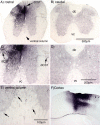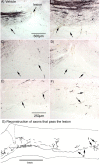Regenerative growth of corticospinal tract axons via the ventral column after spinal cord injury in mice
- PMID: 18596159
- PMCID: PMC2745399
- DOI: 10.1523/JNEUROSCI.5372-07.2008
Regenerative growth of corticospinal tract axons via the ventral column after spinal cord injury in mice
Abstract
Studies that have assessed regeneration of corticospinal tract (CST) axons in mice after genetic modifications or other treatments have tacitly assumed that there is little if any regeneration of CST axons in normal mice in the absence of some intervention. Here, we document a previously unrecognized capability for regenerative growth of CST axons in normal mice that involves growth past the lesion via the ventral column. Mice received dorsal hemisection injuries at thoracic level 6-7, which completely transect descending CST axons in the dorsal and dorsolateral column. Corticospinal projections were traced by injecting biotinylated dextran amine (BDA) into the sensorimotor cortex of one hemisphere either at the time of the injury or 4 weeks after injury, and mice were killed at 20-23 or 46 d after injury. At 20-23 d after injury, BDA-labeled CST axons did not extend past the lesion except in one animal. By 46 d after injury, however, a novel population of BDA-labeled CST axons could be seen extending from the gray matter rostral to the injury into the ventral column, past the lesion, and then back into the gray matter caudal to the injury in which they formed elaborate terminal arbors. The number of axons with this highly unusual trajectory was small ( approximately 1% of the total number of labeled CST axons rostral to the injury). The BDA-labeled axons in the ventral column were on the same side as the main tract and thus are not spared ventral CST axons (which would be contralateral to the main tract). These results indicate that normal mice have a capacity for CST regeneration that has not been appreciated previously, which has important implications in studying the effect of genetic or pharmacological manipulations on CST regeneration in mice.
Figures









Similar articles
-
Comprehensive Corticospinal Labeling with mu-crystallin Transgene Reveals Axon Regeneration after Spinal Cord Trauma in ngr1-/- Mice.J Neurosci. 2015 Nov 18;35(46):15403-18. doi: 10.1523/JNEUROSCI.3165-15.2015. J Neurosci. 2015. PMID: 26586827 Free PMC article.
-
Variable laterality of corticospinal tract axons that regenerate after spinal cord injury as a result of PTEN deletion or knock-down.J Comp Neurol. 2016 Sep 1;524(13):2654-76. doi: 10.1002/cne.23987. Epub 2016 Mar 9. J Comp Neurol. 2016. PMID: 26878190 Free PMC article.
-
The dorsolateral corticospinal tract in mice: an alternative route for corticospinal input to caudal segments following dorsal column lesions.J Comp Neurol. 2004 May 10;472(4):463-77. doi: 10.1002/cne.20090. J Comp Neurol. 2004. PMID: 15065120
-
Intrinsic regulation of axon regeneration after spinal cord injury: Recent advances and remaining challenges.Exp Neurol. 2022 Nov;357:114198. doi: 10.1016/j.expneurol.2022.114198. Epub 2022 Aug 6. Exp Neurol. 2022. PMID: 35944658 Review.
-
Rodent spinal cord injury models for studies of axon regeneration.Exp Neurol. 2017 Jan;287(Pt 3):374-383. doi: 10.1016/j.expneurol.2016.06.029. Epub 2016 Jun 29. Exp Neurol. 2017. PMID: 27374113 Review.
Cited by
-
Nonspecific labeling limits the utility of Cre-Lox bred CST-YFP mice for studies of corticospinal tract regeneration.J Comp Neurol. 2015 Dec 15;523(18):2665-82. doi: 10.1002/cne.23809. Epub 2015 Aug 10. J Comp Neurol. 2015. PMID: 25976033 Free PMC article.
-
p53 Regulates the neuronal intrinsic and extrinsic responses affecting the recovery of motor function following spinal cord injury.J Neurosci. 2012 Oct 3;32(40):13956-70. doi: 10.1523/JNEUROSCI.1925-12.2012. J Neurosci. 2012. PMID: 23035104 Free PMC article.
-
Paired immunoglobulin-like receptor B knockout does not enhance axonal regeneration or locomotor recovery after spinal cord injury.J Biol Chem. 2011 Jan 21;286(3):1876-83. doi: 10.1074/jbc.M110.163493. Epub 2010 Nov 18. J Biol Chem. 2011. PMID: 21087927 Free PMC article.
-
Schwann cell transplantation and descending propriospinal regeneration after spinal cord injury.Brain Res. 2015 Sep 4;1619:104-14. doi: 10.1016/j.brainres.2014.09.038. Epub 2014 Sep 26. Brain Res. 2015. PMID: 25257034 Free PMC article. Review.
-
Biomaterial-mediated delivery of traditional Chinese medicine ingredients for spinal cord injury: a systematic review.Front Pharmacol. 2024 Oct 31;15:1461708. doi: 10.3389/fphar.2024.1461708. eCollection 2024. Front Pharmacol. 2024. PMID: 39545067 Free PMC article.
References
-
- Bareyre FM, Kerschensteiner M, Raineteau O, Mettenleiter TC, Weinmann O, Schwab ME. The injured spinal cord spontaneously forms a new intraspinal circuit in adult rats. Nat Neurosci. 2004;7:269–277. - PubMed
-
- Bareyre FM, Kerschensteiner M, Misgeld T, Sanes JR. Transgenic labeling of the corticospinal tract for monitoring axonal responses to spinal cord injury. Nat Med. 2005;11:1355–1360. - PubMed
-
- Brösamle C, Schwab ME. Ipsilateral, ventral corticospinal tract of the adult rat: ultrastructure, myelination and synaptic connections. J Neurocytol. 2000;29:499–507. - PubMed
-
- Bulsara KR, Iskandar BJ, Villavicencio AT, Skene JH. A new millenium for spinal cord regeneration: growth-associated genes. Spine. 2002;27:1946–1949. - PubMed
Publication types
MeSH terms
Substances
Grants and funding
LinkOut - more resources
Full Text Sources
Medical
Miscellaneous
